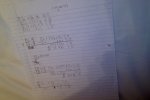Pairs of Numbers Divisible By Seven (Unusual Question)
First of all, I don't go to school in the states so I don't know what the difference between "pre-algebra," and "intermediate/advanced algebra" is. If I've posted this in the wrong place, then I apologise as I'm honestly not sure where it should go. It's a bit of an odd question.
The question: n is a three digit number and m is the number obtained by reversing the order of the digits in n. Suppose that m does not equal n, and that n+m and n-m are both divisible by seven. Find all possible pairs of n and m.
My work so far:
n = 100a + 10b + c
m = 100c + 10b + a
n+m = 101a + 20b + 101c
n-m = 99c - 99a
There are 128 three digit multiples of 7, including 64 even and 64 odd. For each pair of m and n, either both numbers are even or both are odd. Therefore, for each value of n the first and last digit are both either even or odd. 546 & 553 are the 64th & 65th three digits multiples of 7 (those in the middle.) n and m are always both multiples of seven.
I'd greatly appreciate any help that could be offered.
First of all, I don't go to school in the states so I don't know what the difference between "pre-algebra," and "intermediate/advanced algebra" is. If I've posted this in the wrong place, then I apologise as I'm honestly not sure where it should go. It's a bit of an odd question.
The question: n is a three digit number and m is the number obtained by reversing the order of the digits in n. Suppose that m does not equal n, and that n+m and n-m are both divisible by seven. Find all possible pairs of n and m.
My work so far:
n = 100a + 10b + c
m = 100c + 10b + a
n+m = 101a + 20b + 101c
n-m = 99c - 99a
There are 128 three digit multiples of 7, including 64 even and 64 odd. For each pair of m and n, either both numbers are even or both are odd. Therefore, for each value of n the first and last digit are both either even or odd. 546 & 553 are the 64th & 65th three digits multiples of 7 (those in the middle.) n and m are always both multiples of seven.
I'd greatly appreciate any help that could be offered.
Last edited:

